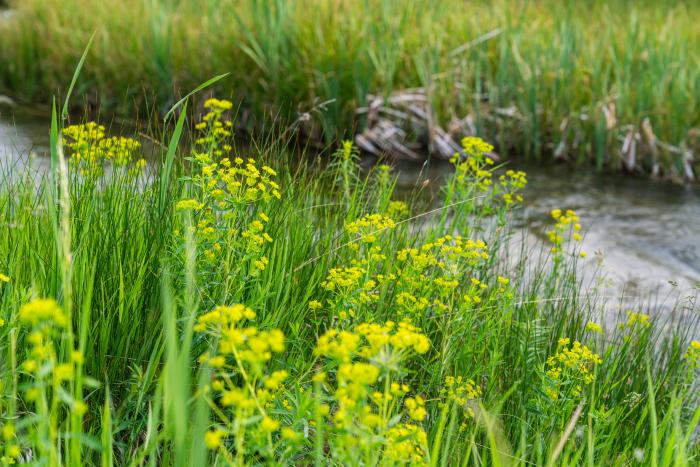Landowners Tackle Leafy Spurge through Focused Conservation
Private landowners along Spring Creek have partnered with the NRCS to develop a Targeted Implementation Plan through Montana Focused Conservation.
This TIP specifically addresses leafy spurge infestations in the Spring Creek riparian area. As Spring Creek empties into the Teton River, the project also decreases the further spread of leafy spurge to downstream riparian areas. Hear from landowner, Mary Sexton.
Watch their story in Conservation for the Future: Spring Creek Leafy Spurge, Choteau, MT.

A tributary of the Teton River, Spring Creek is an underground aquifer running eight and half miles through private land into the town of Choteau and eventually emptying into the Teton River. Despite being a fresh, clear running creek, along its banks arises a decades-long problem – heavy infestation of weeds, most specifically the exotic perennial known as Leafy Spurge.
Introduced to the area a half century ago as an ornamental, Leafy Spurge is a deep-rooted, hard-to-kill weed that grows quickly and competes with native and non-native grasses. Spurge continues to increase along the riparian areas spreading its seeds through the water. “Quite frankly, I think it came from landowners who for years and years did nothing – no spray, no bugs – and it became out of control,” states landowner Mary Sexton. “Unless there is a huge breakthrough, I don’t know that there’s ever going to be a way to totally eradicate spurge, it keeps coming in through ditch system and the creeks.”
Since Mary and her husband took over her grandfather’s ranch seven years ago, they have continued, with varying levels of success, to fight spurge across their land, specifically along the one mile of Spring Creek running through their property. “The riparian areas are tricky but for the rangelands and hay ground, we wanted to start methodically dealing with the spurge,” states Mary. “We got cost share money from the Fish and Wildlife Service to do some weed control. But it’s very expensive, plus it’s a lot of chemical. We wanted to be very targeted in how and where we used it.” In 2015, Mary did more spot spraying and started bug collection and distribution of flea beetles. “The flea beetle has been used successfully to fight spurge west of here.”
Through the years, landowners along Spring Creek continued fighting spurge through cooperative management approaches but two years of flooding and extremely cold weather killed biological control of the weeds. “With the loss of flea beetles, a lot of noxious weeds along the riparian areas just exploded,” NRCS District Conservationist Paula Gunderson explains.
While Mary and her neighbors waged war against the elements to manage their weed problem, local working groups were convening through NRCS Montana Focused Conservation efforts to address county-wide natural resource issues. “Taking a new approach to conservation, Montana Focused Conservation concentrates on a resource concern or geographic area or a combination of both,” continues Gunderson. “This is a way for us to show that we can focus on a geographic region and see that we are making a difference.”
Weeds topped the list.
Stakeholders, landowners and other agencies across the county met to prioritize their top five county-wide natural resource issues, weeds were at the top of the list. “Mary came to us to ask about cost share money to target those weeds and this fell in line with what we were doing with our Targeted Implementation Plan (TIP),” explains Gunderson.
Mary and her neighbors came together to participate in the NRCS Environmental Quality Incentives Program TIP for their combined 1,500 acres of hillside and grazing land and the roughly five-hundred acres of heavily infested riparian areas. This group effort gave Mary an opportunity to go beyond spot spraying and do more broadcast spraying on the grazing lands and hillsides - areas that are productive or if managed, could be more productive.
“This project fit neatly into what we were looking for as a watershed or geographic level project,” states NRCS Rangeland Management Specialist Jim Olson. “This is a unique corridor where we don’t have a lot of producers or landowners,” he continues. “This is one of those rare occasions with weeds where we can take a true watershed and at least address everybody in the project area. This is really an ideal scenario for weed management in a geographic area.”
With the help of NRCS, Mary and her neighbors are mounting a dual ‘attack’ with targeted, professional broadcast chemical application to hillsides and pasture lands and biological control along riparian areas using flea beetles. Mary put out two boxes of roughly 1,000 beetles each in 2020 and is excited to see them present and active nearly a year later. “This is good, this is good. I am pleased,” she exclaims. Another shipment of flea beetles is set to arrive this week and Mary plans to put them out on the ridge above and along another section of the creek. “They don’t do well in shaded areas, but I am thinking in the long run, bugs are going to be more effective.”
“We’re getting into the first year of implementation,” states Olson. “With NRCS help, we can give people additional tools. For instance, Mary was able to hire commercial applicators that she wouldn’t have been able to do on her own and with our monitoring, we’re hoping to see people putting less chemical on the ground and develop more adaptable approaches to pest management in general.”
In the first of a three-year chemical and biological application along with a photo monitoring program, positive results are already evident, “This has put a sizeable dent in our issue; it’s not going to eradicate it but it will certainly help us to manage more effectively,” concludes Mary.

